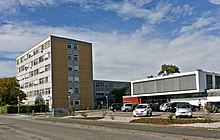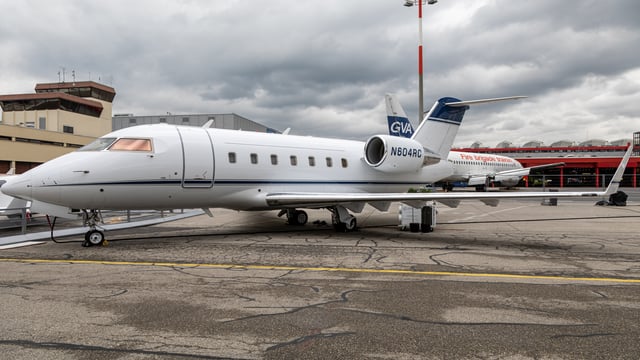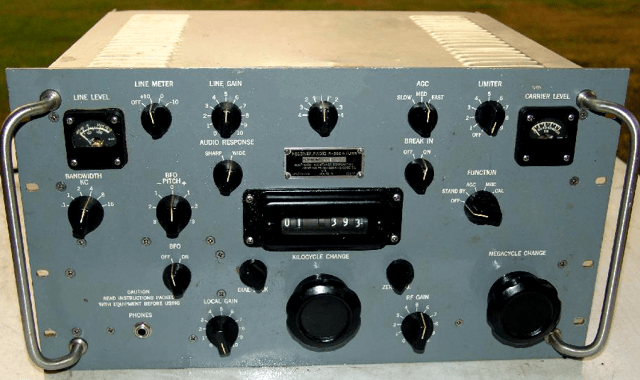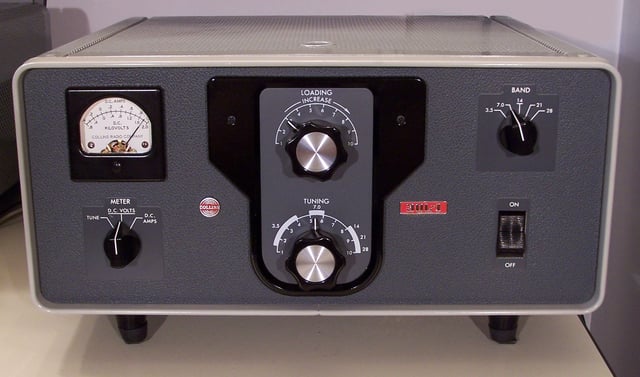Rockwell Collins

Rockwell Collins

 | |
Former type | Subsidiary |
|---|---|
| Industry | Aerospace industry, Defense |
| Fate | Acquired by United Technologies Corporation and merged with UTC Aerospace to form Collins Aerospace |
| Successor | Collins Aerospace |
| Founded | 1933 (1933) |
| Founder | Arthur A. Collins |
| Defunct | November 27, 2018 (2018-11-27) |
| Headquarters | Cedar Rapids, Iowa, USA |
| Products | Avionics, Radios |
| Revenue | |
Operating income | |
Net income | |
Number of employees | 31,200 (2018)[2] (2017) |
| Website | www.rockwellcollins.com/ [48] |
Rockwell Collins was a multinational corporation company headquartered in Cedar Rapids, Iowa providing avionics and information technology systems and services to government agencies and aircraft manufacturers. The company was acquired by United Technologies Corporation on November 27, 2018, and now operates as part of Collins Aerospace.
 | |
Former type | Subsidiary |
|---|---|
| Industry | Aerospace industry, Defense |
| Fate | Acquired by United Technologies Corporation and merged with UTC Aerospace to form Collins Aerospace |
| Successor | Collins Aerospace |
| Founded | 1933 (1933) |
| Founder | Arthur A. Collins |
| Defunct | November 27, 2018 (2018-11-27) |
| Headquarters | Cedar Rapids, Iowa, USA |
| Products | Avionics, Radios |
| Revenue | |
Operating income | |
Net income | |
Number of employees | 31,200 (2018)[2] (2017) |
| Website | www.rockwellcollins.com/ [48] |
History
Arthur A. Collins founded Collins Radio Company in 1933 in Cedar Rapids, Iowa. It designed and produced both shortwave radio equipment and equipment for the burgeoning AM Broadcast industry. Collins was solicited by the military, the scientific community and by the larger AM radio stations for special equipment. Collins supplied the equipment to establish a communications link with the South Pole expedition of Rear Admiral Richard E. Byrd in 1933.
In 1936, Collins had begun production of the 12H audio console, 12X portable field announcers box, the 300E and 300F broadcast transmitters. Throughout World War II, the 212A1 and 212B1 replaced the 12H design. Collins became the principal supplier of radio and navigation equipment used in the military, where uncompromising performance was required.
In the post war years, the Collins Radio Company expanded its work in all phases of the communications field while broadening its technology. This moved Arthur Collins into a more active role as CEO guiding department leaders holding significant responsibilities. New developments such as flight control instruments, radio communication devices and satellite voice transmissions created great opportunities in the marketplace. Collins Radio Company provided communications for the United States' role in the Space Race, including equipment for astronauts to communicate with earth stations and equipment to track and communicate with spacecraft. Collins communications equipment was used for Projects Mercury, Gemini and Apollo, providing voice communication for every American astronaut traveling through space. In 1973, the U.S. Skylab Program used Collins equipment to provide communication from the astronauts to earth.
Rockwell Collins

Rockwell Collins avionics demonstrator aircraft
After facing financial difficulties, the Collins Radio Company was purchased by Rockwell International in 1973. In 2001, the avionics division of Rockwell International was spun off to form the current Rockwell Collins, Inc., retaining its name. Rockwell Collins is highly concentrated in the defense and commercial avionics markets and no longer markets receivers to the public. The Collins mechanical filter is still in production and does, however, find consumer and commercial use.
On April 28, 2000, Rockwell International Corp and its Rockwell Collins unit agreed to acquire Sony Corp's Sony Trans Com (Irvine, Calif) for undisclosed terms.[3][4] Sony had purchased the business from Sundstrand Corporation in 1989.[5][6] On December 20, 2000, Rockwell Collins expanded its services to commercial and executive aviation in Mercosur countries.[7]
The company has acquired several companies, including Hughes-Avicom's in-flight entertainment business (1998), Sony Trans Com (2000), Intertrade Ltd., Flight Dynamics, K Systems, Inc. (Kaiser companies), Communication Solutions, Inc., Airshow, Inc. (2002), NLX (Simulation Business) in 2003,[8] portions of Evans & Sutherland, TELDIX GmbH, IP Unwired, Anzus Inc. in 2006, Information Technology & Applications Corporation in 2007, Athena Technologies, Datapath Inc. (divested in 2014), SEOS Displays Ltd., Air Routing International in 2010,[9] Computing Technologies for Aviation (CTA) in 2011,[10] ARINC in 2014,[11] and BE Aerospace in 2017.[12]
The company is among the major suppliers of in-flight entertainment onboard aircraft. Rockwell Collins' key competitors in this industry include Panasonic Avionics Corporation, Thales Group, and JetBlue's IFE subsidiary LiveTV.
As of 2010, the company employs over 20,000 people[13] and has an annual turnover of 4.665 billion US dollars. Its non-executive chairman is Anthony Carbone following the retirement of Clayton M. Jones.[14] In September 2012, Kelly Ortberg was appointed as president of the company.[15] In August 2013, Kelly Ortberg was appointed CEO of Rockwell Collins.[16]
Acquisition by United Technologies
Past Products
Broadcast transmitters
In the mid-1930s, the Collins Radio Company constructed and sold transmitters and audio mixing consoles to the broadcast industry.
In 1939, the model 12 Speech Input Console, in addition to the 26C limiter amplifier, was licensed to Canadian Marconi Co. for both sales in Canada and His Majesties Service for the war effort. Collins success in constructing broadcast transmitters continued to grow, selling well over a thousand up to the start of World War II. During World War II, Collins expertise grew in higher power transmitters producing designs which ran well over 15 kilowatts of RF power on a continuous basis. After the war a limited number of AM transmitters were produced called the 300G and remain the finest in low power AM transmitters (300W) ever produced.
Collins remained an important manufacturer of AM and FM broadcast radio transmitters for the commercial market surviving the drastic cost cutting market of the 1960s and 1970s. The transmitter line was later sold to Continental Electronics, which continued to produce a number of Collins designs under its own nameplate before phasing them out in the 1980s.
Shortwave transmitters
Collins produced several shortwave transmitters to the commercial market. A "30" Series production catered to the growing need of state highway patrol agencies and Department of Commerce aviation needs. During World War II, Collins produced high power transmitters for aircraft, notably the ART-13 equipped with automatic tuning circuits, which represented an important enhancement for airborne radio communications.[19]
Amateur radio transmitters included the 32V-1, -2, and -3, KWS-1 and the rack mounted KW-1.[22]
Receivers

Collins R-390A radio receiver
Around 1947, the company introduced their first amateur radio receiver, the 75A-1 (called the 75A). This set achieved excellent stability for the time due to high build quality and the use of a permeability tuned oscillator (PTO) in its second conversion stage. It was one of the few double conversion superheterodynes on the market and covered only the amateur bands.
With the experience gained in the design of the 75A-1, Collins released the 51J-1 receiver, a general coverage HF set covering .5 to 30 MHz. It would be produced in somewhat updated versions (51J-2, 51J-3, 51J-4) for about a decade. It was known as the R-388 and was used in multiple receiver diversity RTTY installations.
The 75A amateur line was updated throughout the early 50s, finishing with the 75A-4, which was released in 1955. The Collins mechanical filter was introduced to consumers in the 75A-3, and the 75A-4 was one of the first receivers marketed specifically as a single sideband receiver.
Around 1950, Collins began designing the R-390 (.5–30 MHz) for the US military. This was intended to be a receiver of the highest performance available, with the ruggedness and serviceability required for military duty. It featured direct mechanical digital frequency readout. The set is composed of several modules for easy field repair—a bad module could simply be swapped out and repaired later, or junked. Sets built during the original 1951 contract cost the government about $2500 each and around 16,000 were produced.
Concurrently, Collins developed the R-389, a long-wave version with fewer than 1000 made. The R-391, another variant of the R-390, allowed choice of 8 different auto-tuned channels.
Three years later, Collins delivered the R-390A[23] to the military. About 54,000 were produced and the set was a military workhorse until the 1970s. Like the R-390, it can outperform many modern radios, to the point that it was designated top secret until the late 1960s.
In 1958 Collins replaced the 75A series with the much smaller 75S series, part of the S/Line, discussed in the next section. These featured mechanical filters, very accurate frequency readout, and excellent stability. At the request of the US government, Collins designed the 51S-1 general coverage set, which was essentially (in intended use) a physically smaller replacement for the 51J series. It was not intended as a replacement for the higher performance R-390A, and unlike the R-390A, it was extensively marketed for commercial use.
Collins produced a few high performance solid state receivers in the 1970s, such as the 651S-1. Like their tube predecessors, these are coveted by collectors today.
Transceivers and systems

Collins S/Line – 516F-2 power supply, 75S-3B receiver, 32S-3 transmitter, 312B-4 console, SM-1 microphone, circa 1969

Collins 30L-1 Amplifier ca. 1970
With the introduction of the S/Line in 1958, Collins moved from designing individual products that could be used together, to ones that were designed to integrate and operate together, in various combinations, as a system. They were the first equipment maker to take this approach. Collins was also the first to introduce a compact HF transceiver, the KWM-1, the year before. Together, these two innovations put Collins temporarily ahead of its competition and set the stage for other manufacturers and the next generation of amateur (and military) HF radio equipment.
The 75S-1 receiver and 32S-1 transmitter, comprising the heart of the S/Line, operated separately or together to transceive. The units included crystal bandpass filters and a new compact PTO design that provided stable, highly linear tuning across 200 kHz band segments. The S/Line tuning dial mechanism was unique when introduced. It used concentric dials and a gear mechanism that provided precise dial resolution, better than 1 kHz.
Within a few years Collins had introduced additional S/Line components, including the 30S-1 kilowatt power amplifier, the 30L-1 desktop power amplifier, and the 62S-1 transverter, which provided coverage of the 6 meter (50 MHz) and 2 meter (144 MHz) amateur bands. The KWM-2 transceiver replaced the KWM-1 using many of the S/Line's design features and matching its styling. Other accessories included speakers, microphones and control consoles.
Illustrating the uniqueness of their new, smaller units in the market, Collins advertisements in the 1950s and early 1960s emphasized the S/Line's physical styling and size as often as they did its performance.[24]
Collins continued to improve the S/Line, first introducing the S-2, then the S-3 units, the 75S-3 (and -3A, -3B and -3C) receiver, and the 32S-3 and -3A transmitters. The -3A and -3C units were identical to the -3 and -3B units, respectively, except they provided an extra set of heterodyne oscillator crystals enabling them to cover extra bands – useful for military, amateur and MARS operation, where operation just outside the regular amateur bands was necessary.
Among amateur radio operators, the S/Line established its reputation as perhaps the most solidly engineered equipment available – and the most costly. As a result, S/Line equipment, and the A-Line and other predecessors, are restored, prized, and operated on the air by collectors today.
Collins continued to produce the S/Line well into the late 1970s and after its acquisition by Rockwell.
In 1978, with the move to solid state design, the S/Line came to an end after a two decade production run. The KWM-380 transceiver was introduced the next year – a break with the past both in its use of transistors and digital technology, and its styling. It would be Collins’ final entry in the amateur radio market until it was discontinued in the mid-1980s.[25]
Computers
In the 1960s, the company designed and sold C-System computerized message switching equipment, built an intranet, and began implementing computer storage of design data for circuit boards and assemblies. They had a goal of automating all functions from parts ordering and inventory to factory scheduling to generation of maintenance provisioning.
With products technically successful and far ahead of their time in many respects, Mr. Collins continued to invest in development at a rate that could not be supported by sales when a downturn occurred, and began to have financial problems.
Network Transmission Systems
Acquisitions
In 2008, Rockwell Collins acquired Athena Technologies for $107 million.[29]
ARINC Acquisition
In August 2013 Rockwell Collins announced the agreement to purchase ARINC. On December 23, 2013 Rockwell Collins announced it had completed its acquisition of ARINC for $1.4 billion[30]. The purchase of ARINC allowed Rockwell Collins to shift their balance in commercial aviation.
B/E Aerospace Acquisition
In April 2017, Rockwell Collins entered the aircraft cabin interiors market through the acquisition of B/E Aerospace for $8.3 billion.[31] Based in Wellington, Florida, B/E products included seating, food and beverage preparation and storage equipment, lighting and oxygen systems, and modular galley and lavatory systems for commercial airliners and business jets. B/E benefits of rival Zodiac Aerospace delivery troubles. Retrofit opportunities are provided by its $12 billion installed base. B/E shareholders received 20% of the new Rockwell which then had $8.1 billion in revenues and $1.9 billion in pre-tax earnings with nearly 30,000 employees.[32]
Rockwell Collins filed for regulatory approval for its intended acquisition of B/E Aerospace, a manufacturer and supplier of aircraft cabin interior products, including cabin seating, lighting, oxygen systems, food and beverage preparation and storage equipment, galleys and lavatories, before the Philippine Competition Commission since the latter has a branch in the Philippines operating a manufacturing plant in Tanauan, Batangas.[33]
As a result of the acquisition, a newly created direct or indirect subsidiary of Rockwell, Quarterback Merger Sub Corp., will merge with and into B/E Aerospace, with the latter surviving the merger as a direct or indirect subsidiary of Rockwell Collins.[33]
Organizational structure
Rockwell Collins has five main divisions:
Commercial Systems (CS)
Government Systems (GS)
International and Service Solutions (I&SS)
Information Management Services (IMS)
Interior Systems (IS)
The CS division services the commercial airline industry and business aircraft, providing navigation, communication, Synthetic vision, other cockpit products such as autoland autopilots, and cabin products such as In Flight Entertainment (IFE). The GS division services primarily the US government and military, but also provides some products and services to foreign governments with close ties to the United States. Notable government related projects that Rockwell Collins has involvement with are Common Avionics Architecture System (CAAS), Joint Tactical Radio System (JTRS), Tactical Targeting Network Technology (TTNT), Defense Advanced GPS Receiver (DAGR), and Future Combat Systems. The I&SS division is an amalgamation of (IB) International Business organization whose responsibility is sales, engineering and human resource of personnel outside of North America and Service Solutions who provides support services such as customer support, simulation and training and technical publications. I&SS provide a common service to both CS and GS divisions and its formation was announced on the Rockwell Collins press release web page on February 19, 2010.[34]
Donald R. Beall Advanced Technology Center
The Donald R. Beall Advanced Technology Center (ATC) is a research and development center within Rockwell Collins that focuses on creating, identifying, and maturing technologies targeted at driving business growth. ATC maintains a portfolio that balances shorter term deliverables focused on core and adjacent markets with technologies for long term growth. ATC has three departments: Advanced Radio Systems, Communications and Navigation Systems, and Embedded Information Systems.
Collector community
As with several other brands of vintage radio equipment, there is an active community of Collins radio enthusiasts, with clubs, web sites and on-line discussions dedicated to restoring and operating the equipment. The Collins Collectors Association (CCA)[35] and the Collins Radio Association (CRA)[36] are two examples of such organizations.
Groups of Collins users also organize meetings, gatherings at hamfests and regularly scheduled on-air discussions called “nets”.
See also
E.F. Johnson
Future Air Navigation System
Hallicrafters
Hammarlund
National Radio Company
R. L. Drake Company
Rockwell Automation
Signal/One
Vintage amateur radio
Collins Aerospace
United Technologies Corporation